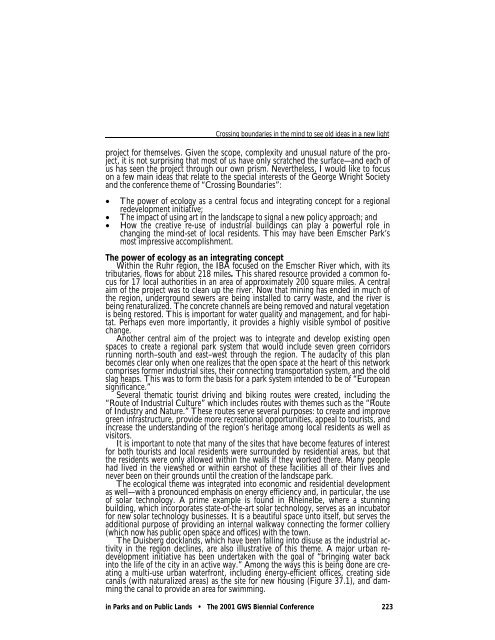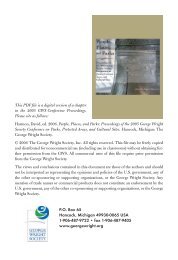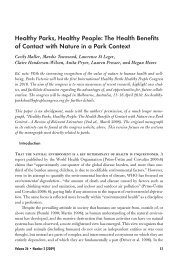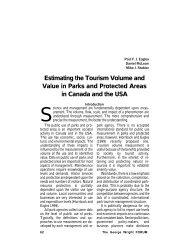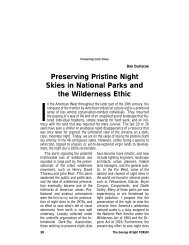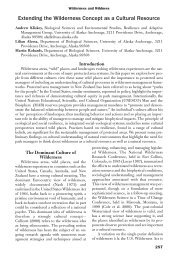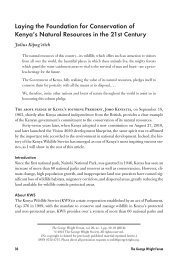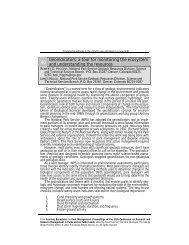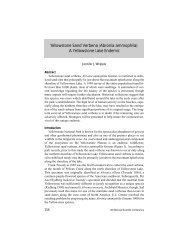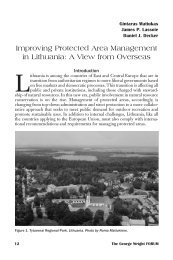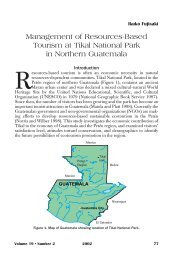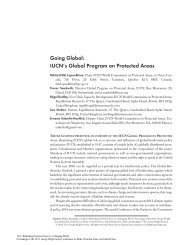Emscher Park, Germany — expanding the definition of a “park”
Emscher Park, Germany — expanding the definition of a “park”
Emscher Park, Germany — expanding the definition of a “park”
You also want an ePaper? Increase the reach of your titles
YUMPU automatically turns print PDFs into web optimized ePapers that Google loves.
Crossing boundaries in <strong>the</strong> mind to see old ideas in a new light<br />
project for <strong>the</strong>mselves. Given <strong>the</strong> scope, complexity and unusual nature <strong>of</strong> <strong>the</strong> project,<br />
it is not surprising that most <strong>of</strong> us have only scratched <strong>the</strong> surface<strong>—</strong>and each <strong>of</strong><br />
us has seen <strong>the</strong> project through our own prism. Never<strong>the</strong>less, I would like to focus<br />
on a few main ideas that relate to <strong>the</strong> special interests <strong>of</strong> <strong>the</strong> George Wright Society<br />
and <strong>the</strong> conference <strong>the</strong>me <strong>of</strong> “Crossing Boundaries”:<br />
• The power <strong>of</strong> ecology as a central focus and integrating concept for a regional<br />
redevelopment initiative;<br />
• The impact <strong>of</strong> using art in <strong>the</strong> landscape to signal a new policy approach; and<br />
• How <strong>the</strong> creative re-use <strong>of</strong> industrial buildings can play a powerful role in<br />
changing <strong>the</strong> mind-set <strong>of</strong> local residents. This may have been <strong>Emscher</strong> <strong>Park</strong>’s<br />
most impressive accomplishment.<br />
The power <strong>of</strong> ecology as an integrating concept<br />
Within <strong>the</strong> Ruhr region, <strong>the</strong> IBA focused on <strong>the</strong> <strong>Emscher</strong> River which, with its<br />
tributaries, flows for about 218 miles. This shared resource provided a common focus<br />
for 17 local authorities in an area <strong>of</strong> approximately 200 square miles. A central<br />
aim <strong>of</strong> <strong>the</strong> project was to clean up <strong>the</strong> river. Now that mining has ended in much <strong>of</strong><br />
<strong>the</strong> region, underground sewers are being installed to carry waste, and <strong>the</strong> river is<br />
being renaturalized. The concrete channels are being removed and natural vegetation<br />
is being restored. This is important for water quality and management, and for habitat.<br />
Perhaps even more importantly, it provides a highly visible symbol <strong>of</strong> positive<br />
change.<br />
Ano<strong>the</strong>r central aim <strong>of</strong> <strong>the</strong> project was to integrate and develop existing open<br />
spaces to create a regional park system that would include seven green corridors<br />
running north–south and east–west through <strong>the</strong> region. The audacity <strong>of</strong> this plan<br />
becomes clear only when one realizes that <strong>the</strong> open space at <strong>the</strong> heart <strong>of</strong> this network<br />
comprises former industrial sites, <strong>the</strong>ir connecting transportation system, and <strong>the</strong> old<br />
slag heaps. This was to form <strong>the</strong> basis for a park system intended to be <strong>of</strong> “European<br />
significance.”<br />
Several <strong>the</strong>matic tourist driving and biking routes were created, including <strong>the</strong><br />
“Route <strong>of</strong> Industrial Culture” which includes routes with <strong>the</strong>mes such as <strong>the</strong> “Route<br />
<strong>of</strong> Industry and Nature.” These routes serve several purposes: to create and improve<br />
green infrastructure, provide more recreational opportunities, appeal to tourists, and<br />
increase <strong>the</strong> understanding <strong>of</strong> <strong>the</strong> region’s heritage among local residents as well as<br />
visitors.<br />
It is important to note that many <strong>of</strong> <strong>the</strong> sites that have become features <strong>of</strong> interest<br />
for both tourists and local residents were surrounded by residential areas, but that<br />
<strong>the</strong> residents were only allowed within <strong>the</strong> walls if <strong>the</strong>y worked <strong>the</strong>re. Many people<br />
had lived in <strong>the</strong> viewshed or within earshot <strong>of</strong> <strong>the</strong>se facilities all <strong>of</strong> <strong>the</strong>ir lives and<br />
never been on <strong>the</strong>ir grounds until <strong>the</strong> creation <strong>of</strong> <strong>the</strong> landscape park.<br />
The ecological <strong>the</strong>me was integrated into economic and residential development<br />
as well<strong>—</strong>with a pronounced emphasis on energy efficiency and, in particular, <strong>the</strong> use<br />
<strong>of</strong> solar technology. A prime example is found in Rheinelbe, where a stunning<br />
building, which incorporates state-<strong>of</strong>-<strong>the</strong>-art solar technology, serves as an incubator<br />
for new solar technology businesses. It is a beautiful space unto itself, but serves <strong>the</strong><br />
additional purpose <strong>of</strong> providing an internal walkway connecting <strong>the</strong> former colliery<br />
(which now has public open space and <strong>of</strong>fices) with <strong>the</strong> town.<br />
The Duisberg docklands, which have been falling into disuse as <strong>the</strong> industrial activity<br />
in <strong>the</strong> region declines, are also illustrative <strong>of</strong> this <strong>the</strong>me. A major urban redevelopment<br />
initiative has been undertaken with <strong>the</strong> goal <strong>of</strong> “bringing water back<br />
into <strong>the</strong> life <strong>of</strong> <strong>the</strong> city in an active way.” Among <strong>the</strong> ways this is being done are creating<br />
a multi-use urban waterfront, including energy-efficient <strong>of</strong>fices, creating side<br />
canals (with naturalized areas) as <strong>the</strong> site for new housing (Figure 37.1), and damming<br />
<strong>the</strong> canal to provide an area for swimming.<br />
in <strong>Park</strong>s and on Public Lands • The 2001 GWS Biennial Conference 223


